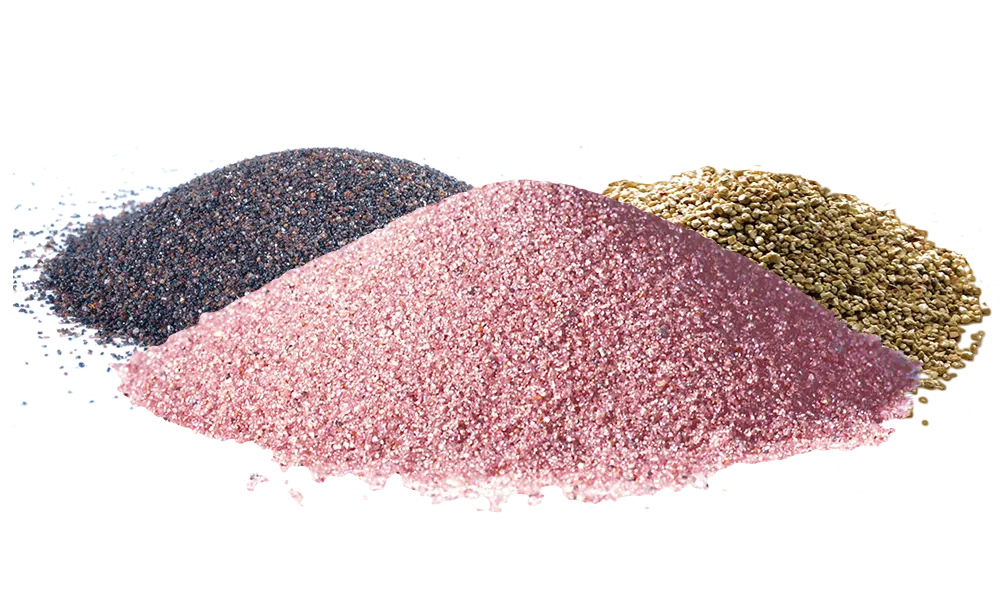In the world of manufacturing and material finishing, abrasives play a crucial role in shaping, finishing, and cleaning surfaces. Abrasives are materials, often minerals, that are used to finish or shape a workpiece through rubbing, which leads to part of the workpiece being worn away. Understanding the different types of abrasives and their properties is essential for selecting the right material for a specific application. This article explores the four basic types of abrasives commonly used in the industry: Aluminum Oxide, Silicon Carbide, Ceramic, and Garnet.
1. Aluminum Oxide
Properties
Aluminum oxide is a synthetic abrasive made from bauxite, a sedimentary rock with a high aluminum content. It is renowned for its high hardness, rated at 9 on the Mohs scale, which is just one point below diamond. This exceptional hardness endows it with an outstanding abrasive capacity, making it efficient in achieving the desired results on various materials. Its high impact resistance makes it especially suitable for recycling during the sandblasting process. This characteristic makes it particularly effective for grinding high-tensile materials such as carbon steel, alloy steel, tough bronze, and other metals. With a diverse range of types and particle sizes, Aluminum Oxide can meet a wide array of needs concerning roughness and surface finishing.
Applications
- Grinding Wheels: Aluminum oxide is commonly used in the manufacture of grinding wheels where high precision and fine finishes are required.
- Sanding Belts and Discs: It is also used in coated abrasives such as sanding belts and discs for woodworking and metalworking applications.
- Surface Preparation: Aluminum oxide is employed for surface preparation before painting or applying coatings.
2. Silicon Carbide
Properties
Silicon carbide is a sharper and harder abrasive compared to aluminum oxide. This makes it particularly effective for applications requiring a high degree of precision and a smooth finish. It is a synthetic material produced through a process that heats silica sand and carbon to high temperatures in an electric furnace, making it ideal for high-temperature applications. The hardness of silicon carbide allows for much quicker cutting and generates less heat during the process.
Applications
- Cutting Hard Materials: Due to its hardness, silicon carbide is ideal for cutting stone, glass, ceramics, and other hard materials.
- Grinding Wheels: It is used in grinding wheels for applications that require rapid material removal.
- Wire Sawing: Silicon carbide is also used in wire sawing applications, particularly in the electronics industry for cutting and slicing delicate silicon wafers.
3. Natural Abrasives
Properties
Natural abrasives, such as Garnet, Emery, Flint, and Diamond, have been used for centuries for grinding and polishing. Emery, a mixture of corundum and magnetite, is used for abrasive powder. Flint (or silica) was traditionally used in the manufacture of scouring soaps and polishing powders. Diamond, the hardest material known, is used for cutting, grinding, and drilling high-hardness materials. Garnet is a natural abrasive mined from deposits of minerals that were originally formed by crystalline rocks. The natural properties of garnet — hardness, sharpness, and durability — make it an excellent choice for abrasive blasting and water jet cutting.
Applications
- Abrasive Blasting: Natural Abrasives is used in abrasive blasting treatments for preparing surfaces before painting or coating.
- Water Jet Cutting: Due to its sharpness and high density, garnet is ideal for water jet cutting applications, particularly in cutting intricate designs in materials like stainless steel or marble.
- Cutting: Cutting hard materials such as concrete, stone, and metal.
- Surface treatment: used as abrasive powder and abrasive coating tools for polishing, grinding, and cleaning surfaces.
4. Synthetic Abrasives
Properties
In addition to naturally occurring abrasives, synthetic options have been developed to meet specific industrial needs. These include synthetic diamond, cubic boron nitride (CBN), and ceramic abrasives. Synthetic diamond is widely used in cutting and drilling tools. CBN, second only to diamond in hardness, is used for machining hard ferrous metals. Ceramic abrasives are manufactured through a sintering process that fuses synthetic materials at high temperatures to produce an incredibly tough and sharp abrasive grain. They are designed to fracture under pressure, consistently exposing fresh, sharp edges that excel in rapid stock removal. Ceramics are generally tougher than other abrasives and are used in severe grinding applications.
Applications
- Sandblasting: Sandblasting is a process where a stream of abrasive material is propelled under high pressure to clean or modify the surface texture of materials. Due to its non-toxic nature, as it does not contain free silica or other harmful components, synthetic corundum is preferred over cheaper alternatives for health and safety reasons.
- Grinding and Polishing: These tools are employed in the grinding, polishing, and finishing of metal, wood, and other materials, where they help achieve the desired surface quality and texture.
- Cutting: Abrasive cutting wheels made from synthetic materials are used to cut through metals and other hard materials.
- Lapping and Honing: Synthetic abrasives are used in lapping and honing processes, which are fine material removal practices used to produce smooth and precise surfaces on metal parts.
Conclusion
The choice of abrasive material is critical in determining the efficiency, cost, and quality of the manufacturing process. From the high hardness of Aluminum Oxide and Silicon Carbide to the unique properties of natural and synthetic abrasives, each type has its specific applications and advantages.
